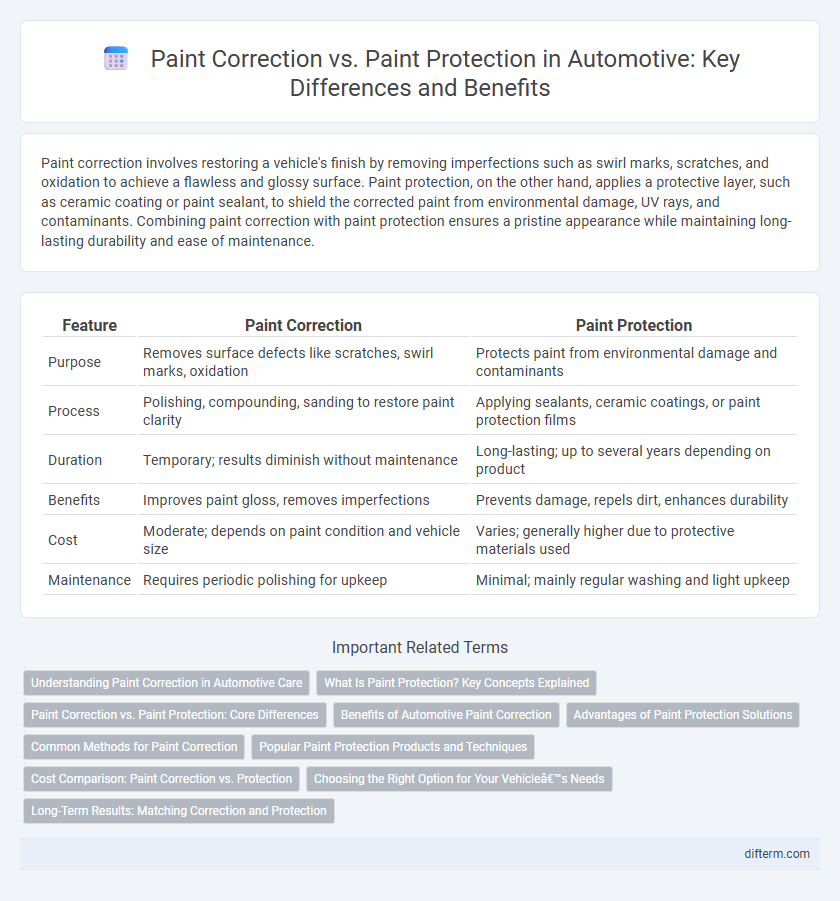Paint correction involves restoring a vehicle's finish by removing imperfections such as swirl marks, scratches, and oxidation to achieve a flawless and glossy surface. Paint protection, on the other hand, applies a protective layer, such as ceramic coating or paint sealant, to shield the corrected paint from environmental damage, UV rays, and contaminants. Combining paint correction with paint protection ensures a pristine appearance while maintaining long-lasting durability and ease of maintenance.
Table of Comparison
| Feature | Paint Correction | Paint Protection |
|---|---|---|
| Purpose | Removes surface defects like scratches, swirl marks, oxidation | Protects paint from environmental damage and contaminants |
| Process | Polishing, compounding, sanding to restore paint clarity | Applying sealants, ceramic coatings, or paint protection films |
| Duration | Temporary; results diminish without maintenance | Long-lasting; up to several years depending on product |
| Benefits | Improves paint gloss, removes imperfections | Prevents damage, repels dirt, enhances durability |
| Cost | Moderate; depends on paint condition and vehicle size | Varies; generally higher due to protective materials used |
| Maintenance | Requires periodic polishing for upkeep | Minimal; mainly regular washing and light upkeep |
Understanding Paint Correction in Automotive Care
Paint correction in automotive care involves the meticulous process of removing surface imperfections such as swirl marks, scratches, and oxidation to restore a vehicle's original paint finish. This technique utilizes specialized compounds and polishing tools to refine the clear coat, enhancing gloss and depth. Understanding paint correction is crucial for achieving a flawless base before applying paint protection products that safeguard the vehicle's appearance over time.
What Is Paint Protection? Key Concepts Explained
Paint protection refers to the application of specialized coatings or films designed to shield a vehicle's exterior from environmental damage such as UV rays, chemical stains, and minor abrasions. Common methods include ceramic coatings, paint protection films (PPF), and sealants that create a durable barrier preserving the vehicle's finish. Unlike paint correction, which focuses on restoring existing paint imperfections, paint protection aims to maintain the pristine condition of the vehicle's surface over time.
Paint Correction vs. Paint Protection: Core Differences
Paint correction involves the meticulous removal of surface imperfections like swirl marks, scratches, and oxidation through polishing and compounding techniques to restore the vehicle's paint to a flawless finish. Paint protection, on the other hand, focuses on applying protective coatings such as ceramic, clear bra, or wax to shield the paint from environmental damage, UV rays, and contaminants. While paint correction enhances the vehicle's aesthetic by repairing damage, paint protection preserves the restored finish and prolongs its durability.
Benefits of Automotive Paint Correction
Automotive paint correction restores the vehicle's original finish by removing imperfections such as swirl marks, scratches, oxidation, and water spots, significantly enhancing the car's appearance and value. This process enables better paint clarity and depth, resulting in a smoother and more reflective surface that amplifies the effectiveness of subsequent paint protection treatments. Furthermore, paint correction extends the lifespan of the vehicle's paintwork by addressing surface damage early, reducing the risk of rust and corrosion.
Advantages of Paint Protection Solutions
Paint protection solutions offer long-lasting defense against environmental damage such as UV rays, acid rain, and road debris, effectively preserving the vehicle's factory paint finish. Advanced ceramic coatings create a hydrophobic surface that repels water, reduces dirt buildup, and simplifies cleaning, maintaining a glossy appearance with less effort. Unlike paint correction, which restores surface imperfections, paint protection proactively prevents scratches, oxidation, and fading, significantly extending the lifespan and value of automotive paint.
Common Methods for Paint Correction
Common methods for paint correction include machine polishing, wet sanding, and compounding, which effectively remove surface imperfections like swirl marks, scratches, and oxidation. These techniques restore the vehicle's original paint clarity and gloss by leveling the clear coat and refining the surface texture. Paint correction is often a prerequisite before applying paint protection products such as ceramic coatings or sealants to ensure maximum adhesion and durability.
Popular Paint Protection Products and Techniques
Popular paint protection products in the automotive industry include ceramic coatings, paint protection films (PPF), and sealants, each offering varying levels of durability and resistance against environmental contaminants. Ceramic coatings provide a nanoscale barrier enhancing gloss and hydrophobic properties, while PPF delivers a robust physical shield against scratches, rock chips, and UV damage. Techniques like professional application of multi-layer ceramic coatings and precise PPF installation ensure maximum longevity and preservation of the vehicle's paint finish.
Cost Comparison: Paint Correction vs. Protection
Paint correction typically costs between $150 and $1,000 depending on the vehicle size, paint condition, and extent of defects, as it involves removing surface imperfections through polishing and compounding. Paint protection, including ceramic coatings or paint protection films (PPF), ranges from $500 to $3,000, offering a long-term barrier against environmental damage and reducing the need for frequent detailing. When comparing cost efficiency, paint protection proves more economical over time by preserving the corrected finish and minimizing future correction expenses.
Choosing the Right Option for Your Vehicle’s Needs
Paint correction restores your vehicle's finish by removing surface imperfections like swirl marks, scratches, and oxidation, enhancing overall appearance and preparing the surface for protection. Paint protection, such as ceramic coatings or paint protection film (PPF), safeguards the corrected surface from environmental damage, UV rays, and contaminants, preserving the vehicle's aesthetic and value. Evaluating your vehicle's current condition, usage patterns, and desired maintenance effort helps determine whether immediate paint correction or long-term paint protection is the best investment for optimal results.
Long-Term Results: Matching Correction and Protection
Paint correction eliminates surface imperfections like scratches and swirl marks, restoring the vehicle's finish to a flawless state. Paint protection, such as ceramic coatings or paint sealants, creates a durable barrier that guards against environmental damage, UV rays, and contaminants, preserving the correction's results. Matching high-quality correction techniques with advanced protective coatings ensures long-term aesthetic enhancement and reduces the need for frequent maintenance.
paint correction vs paint protection Infographic

 difterm.com
difterm.com